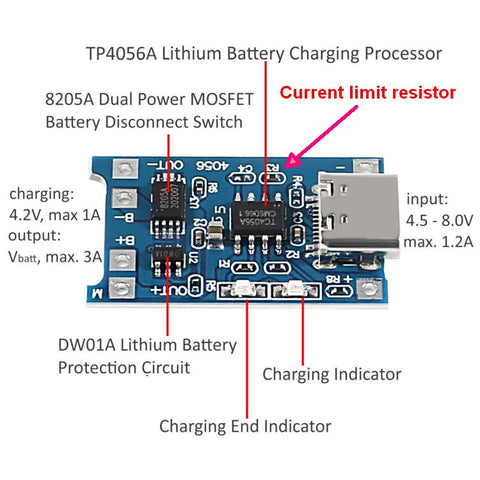Lithium Battery Charging module review
A lithium battery charging module is like a superhero for your battery! This guardian ensures your battery is charged up and ready to go without overcharging or over-discharging. All this will extend the life of your battery drastically and keep it safe to use,
There will come a time when you want to have your project mobile. The easiest way to accomplish that is with batteries. If you want to get a bit fancy, rechargeable Lithium batteries.
This module also include a protection circuit board which will protect your battery from short-circuiting, overcharging and over discharge. With a few simple steps, you can easily protect and increase your battery life!
I am reviewing the lithium Battery Charging module that is also available from us here. It is a low-cost unit that is affordable enough to build into your projects directly without worrying about opening a box, removing the batteries for charging and then putting it back again. So, except for saving on the cost of a charger, you now have an easy-to-charge project.
POWER TO THE BOARD.
It comes with a USB connector to connect to a 5V power source. This USB connector is handy because you can join the module to a computer USB port or a 5V power supply, and your cell phone power supply will work great. This module also has a place to solder 5V power supply power wires directly to the board.
FUNCTIONALITY

From the picture above, you can see the two status LEDs on the Lithium Battery Charging module. The charge LED indicates that the battery is charging, and the second LED lights up when the battery is fully charged.
Most of the work is done by the TP4056 IC. It is a constant-current/constant-voltage linear charger IC explicitly designed for Lithium-ion batteries. This IC has many features, including automatic recharging, and can supply a 1A charging current! You will find these chips in cell phones, cameras, charging doc stations etc.
Hooking it up is easy. Supply the Lithium Battery Charging module with 5V and hook up the battery via two wires to the bat+ and bat- power through holes on the board (this requires soldering).
SPECIFICATIONS
- Input voltage: 5V (optimal voltage, do not recommend higher that 6V)
- Maximum charging current: 1000 mA
- Charge cut-off voltage: 4.2 V + / - 1%
- Battery overcharge protection voltage: 2.5 V
- Battery over-current protection current: 3 A
- Input interface: Micro USB or 5V to power terminals
- Dimension: 2.6 x 1.7 cm
CHANGING THE CHARGING CURRENT
This unit supplies 1A constant current to the batteries out of the box, but that might be too high. We recommend that when you charge a battery, you should charge them at 37-40% of the battery capacity(in mAh). For example, if you are charging a battery of 1000mAh capacity, you should adjust the resistance so that the current offered is approximately 370mA-400mA.
Now, this is my only drawback in using this module. You will need to replace the resistor manually. It is an easy process but still extra work to get precisely the amps you require. I was hoping for a variable resistor, but the problem with this is that you will blow the chip if you set the resistance too low, which you will do very quickly if you turn a variable resistor just a bit too far to the wrong side.
In the picture above, you can see the resistor you need to replace if 1A is too high for your batteries. It is easier than you probably think right now. First, use a soldering iron to heat both sides of the resistor simultaneously to remove it. Then, put the new one in place and heat each side to solder it back in place. If you do not have an SMD resistor use a standard 1/4 watt resistor, cutting the legs as short as you can.
Here is a table to work out the size of the resistor you will require:
| Resistor (k) | BAT amps (mA) |
| 30 | 50 |
| 20 | 70 |
| 10 | 130 |
| 5 | 250 |
| 4 | 300 |
| 3 | 400 |
| 2 | 580 |
| 1.66 | 690 |
| 1.5 | 780 |
| 1.33 | 900 |
| 1.2 | 1000 |
SUMMARY
It is cheap and easy to use and can quickly charge bigger Lithium batteries than expected. With the drawback of having to solder in a different resistor to get the correct charging current comes the benefit of being able to charge any chargeable Lithium battery at its optimum levels.
